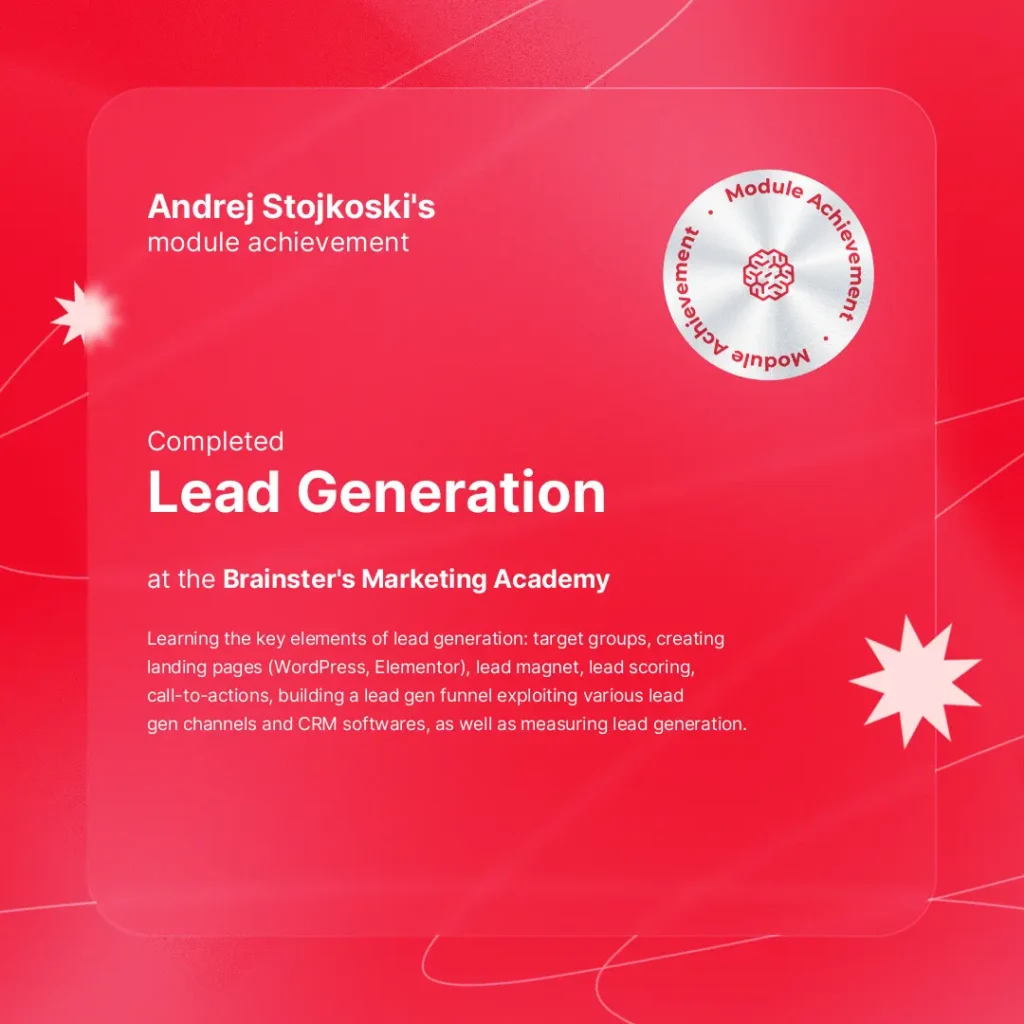Why Lead Generation Matters in Modern Marketing
In today’s digital ecosystem, generating high-quality leads is at the heart of every successful marketing strategy. For me, learning about lead generation wasn’t just about filling out forms or building landing pages—it was about understanding how to attract the right people and turn them into valuable connections.
During my time at Brainster’s Digital Marketing Academy, the Lead Generation module was one of the most practical and hands-on experiences I had. Spanning four intensive weeks, it covered everything from landing page design to CRM systems, lead magnets, and nurturing workflows. It laid the foundation for what modern marketers need to know to create conversion-focused campaigns.
My Expectations for the Lead Generation Module
Coming off the heels of previous modules, I was really excited for this one. I expected it to tie together strategy and execution—taking all that I had learned about value propositions, user targeting, and campaign messaging, and applying it through real tools like WordPress, Elementor, and CRM systems.
What I was most looking forward to was designing a complete lead gen funnel—from capturing attention to nurturing leads post-conversion. I also hoped to build something portfolio-worthy. Spoiler: I did.

What I Learned in the Lead Generation Module
🔹 Building High-Converting Landing Pages
- Learned how to create responsive, conversion-optimized landing pages using WordPress and Elementor.
- Focused on crucial elements like the hero shot, CTA, social proof, and message match.
- Developed both demo and real client pages, analyzing and iterating based on performance and feedback.
🔹 Mastering Elementor
- Worked extensively with Elementor widgets, templates, and layout design.
- Compared features between Elementor Free and Pro to determine the best tools for specific design tasks.
Created and refined layouts for mobile responsiveness, CTA placement, and visual hierarchy.
🔹 Understanding the Psychology of Conversion
- Used A/B testing logic, urgency, and scarcity tactics.
- Practiced how to craft compelling headlines, subtitles, and value propositions.
Analyzed successful landing pages to identify what makes users convert.
🔹 Learning CRM & Lead Management Tools
- Got introduced to CRM systems and learned how to capture, score, and manage leads.
Understood the importance of lead scoring, segmentation, and setting up follow-up workflows.
How I Applied the Lead Generation Module in a Real Project
The capstone of this module was building a lead-generating landing page for a real non-profit organization called Youth Can. This wasn’t a simulation—it was an actual deliverable.
We started with a brief and performed a deep analysis of the target audience and similar landing pages for inspiration. Using WordPress and Elementor, I designed a visually clean and goal-oriented landing page optimized for conversions.
The page included:A compelling hero shot
- Clear CTA buttons placed above and below the fold
- Social proof through testimonials and partners
- A limited-time offer to encourage urgency
- A lead magnet in the form of a downloadable resource
By the end of the module, I had created a page that not only looked professional but was functionally designed to convert visitors into leads.
My Experience with the Lead Generation Module
This module felt like a mini-agency experience. From designing for a real client to gathering feedback from peers and mentors, every part of it mimicked real-world marketing scenarios.
Working with Elementor was especially eye-opening. It gave me a hands-on understanding of how design and structure influence user behavior. The collaborative feedback sessions helped me refine both the visual and functional aspects of my work.
It was also my first time creating a full lead generation funnel—from offering a lead magnet to planning out follow-up nurturing emails that would eventually be automated in the next module on email marketing.
Tools I Used During the Lead Generation Module
Tool/Platform
WordPress
Elementor
Google Docs/Slides
CRM System (Intro)
Email Marketing Software
Purpose
Core platform for building landing pages
Drag-and-drop builder used for page design
Used for wireframes, planning, and feedback
Learned how to collect and manage leads
Drafted nurturing flows for later automation
Top Skills I Gained from the Module
✅ Landing Page Design Mastery
- From headlines to hero shots, learned how to balance content and design for maximum impact.
✅ Funnel Thinking
- Designed multi-step funnels involving CTA clicks, lead magnet downloads, and follow-up messaging.
✅ Strategic Use of Lead Magnets
- Learned how to craft offers that encourage users to submit their contact info willingly.
✅ Segmentation and Lead Scoring
Understood how to differentiate between cold and hot leads, and prioritize follow-ups accordingly.
Why Lead Generation is Essential for Marketers
Whether you’re in B2B or B2C, lead generation is where your marketing truly begins. It’s not just about attracting visitors—it’s about giving them a reason to connect. Through the right combination of messaging, design, tools, and strategy, you can build a lead pipeline that fuels your entire marketing funnel.
This module showed me how it all comes together. It gave me the tools and confidence to plan, design, execute, and measure lead generation campaigns that convert.
Final Thoughts: A Foundation for Future Growth
If I could sum up the Lead Generation module in one word, it would be transformative. It connected theory to action and gave me something concrete I could show—a live, optimized landing page created for a real client.
From now on, when I think about lead generation, I don’t just think about traffic—I think about value exchange, user journey, and real relationships built through intentional design and smart strategy.